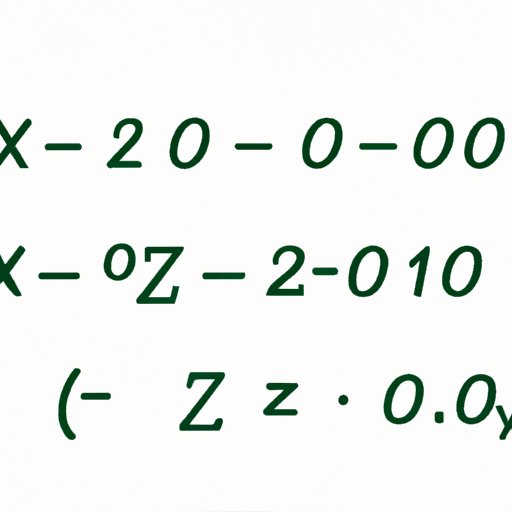
Introduction
Zeros of a function, also known as roots or x-intercepts, are critical points in understanding and analyzing mathematical equations. These are the values of x where a function intersects with the x-axis. Finding zeros is crucial in solving mathematical equations and graphing functions. In this article, we will explore the different methods and techniques for finding zeros of any function.
5 Simple Steps to Finding the Zeros of Any Function
The following steps will guide you in finding the zeros of any function:
1. Rewrite the equation as y = f(x) and set y = 0.
2. Use the quadratic formula to solve for x when the equation is a quadratic.
3. Factor the equation when possible to solve for x.
4. Use approximations or numerical methods when finding zeros is difficult.
5. Check your answer with a graph.
Master the Art of Solving for X: A Beginner’s Guide to Finding Zeros
For beginners, finding zeros can be an intimidating process. Understanding the basic algebraic concepts needed to solve for x is essential in mastering this art. To find the zeros, you need to solve for x when y=0. In other words, you need to find the values of x that will make the function equal zero.
Let’s take a look at the following equation: y = x^2 – 4
To find the zeros of the function, we set y = 0.
0 = x^2 – 4
Add 4 to both sides.
4 = x^2
Find the square root of both sides.
±2 = x
Therefore, the zeros of the function are x = ±2.
From Polynomial to Zeros: A Comprehensive Guide
For polynomial functions, the degree of the function determines the number of zeros it has. For example, a quadratic equation has two zeros, while a cubic equation has three zeros. To find the zeros of polynomial functions, you can use different methods.
For quadratic equations, you can use the quadratic formula:
x = (-b ± √b^2-4ac) / 2a
For higher-degree polynomial functions, you can use factoring and the rational roots theorem to find the zeros.
A Quick and Easy Guide to Finding Roots of a Function
The term “roots” is often used synonymously with “zeros” when referring to finding the x-intercepts of a function. Graphs can help us visually identify zeros. The intersection of the graph and the x-axis indicates that the function has a zero at that point. A calculator can also be used to find zeros by using the “zero” or “root” function.
Solving for Zeros: Tips and Tricks for Success
To become successful in finding zeros, there are a few tips and tricks to keep in mind. One of the easiest ways to solve for zeros of a function is to look for patterns of factors. Divide by common factors and look for other factors that can be factored out of the equation. It is also essential to avoid making common mistakes, such as forgetting to set y equal to zero or not following the correct order of operations.
Uncovering the Mysteries of Zeros: How to Determine Where a Function Crosses the X-Axis
Determining where a function crosses the x-axis is similar to finding its zeros. When a function crosses the x-axis, it means that the corresponding value of y is zero. The zeros of a function are, therefore, the points where the function crosses the x-axis.
Conclusion
Zeros of a function are critical points in solving mathematical equations and graphing functions. By following the methods and techniques outlined in this article, finding zeros of any function will now be a more manageable task. Keep practicing to master this skill, and make sure to check your answers using a graph or calculator. Remember, understanding zeros is essential in solving mathematical problems.





